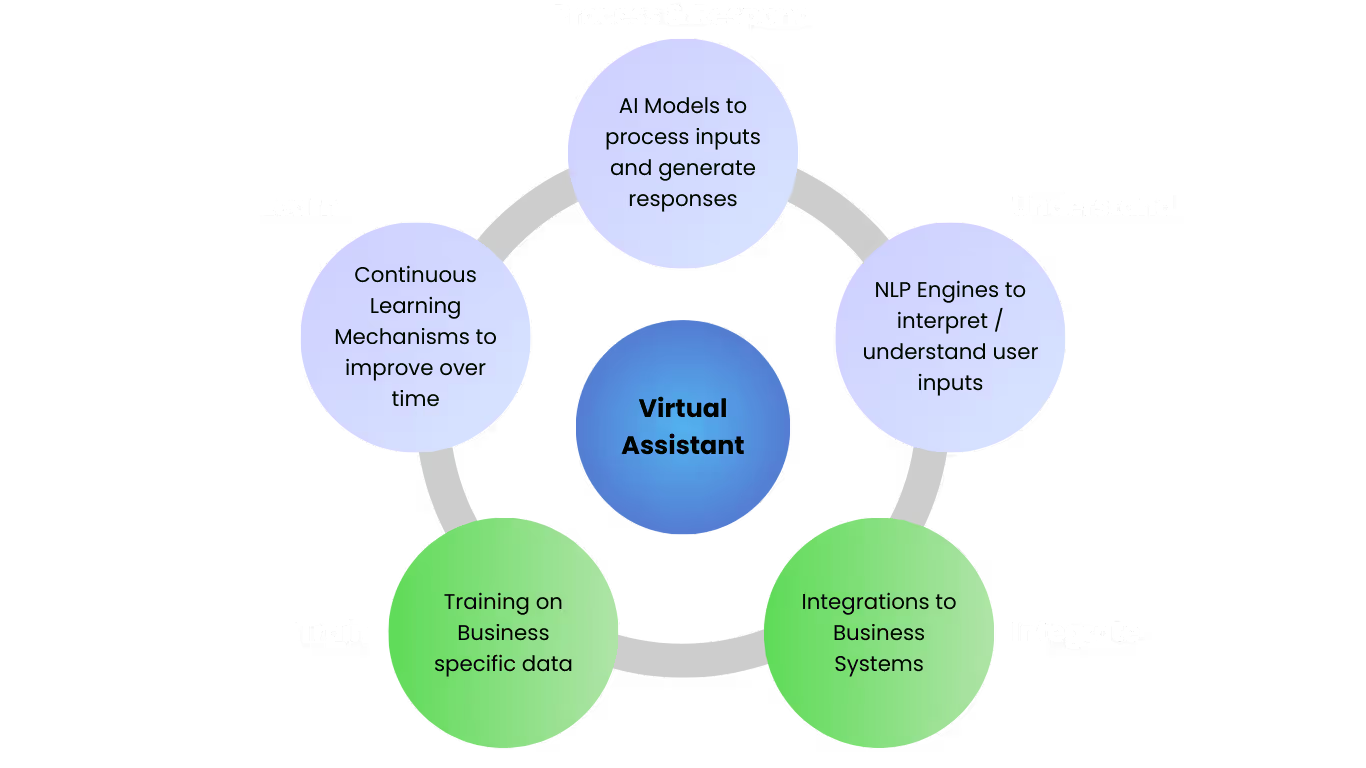

Read Time:
10
Minutes
Innovation @ Ntegra
September 22, 2025
Understanding AI-Powered Virtual Assistants: Building, Benefits, Risks and Selection
Artificial Intelligence (AI) is no longer a futuristic concept—it has become a fundamental driver of digital transformation, reshaping customer interactions and operational efficiency across industries.
With approximately 77% (AuthorityHacker, 2024) of companies already integrating AI in some capacity, the rapid adoption signals both confidence in its potential and the competitive pressure to keep up. But does widespread adoption necessarily equate to meaningful value?
Among the most transformative applications of AI are virtual assistants (VAs)—a key innovation in many digital consultancy services. While Forbes (2024) reports that nearly 47% of AI usage is in personal assistants, the question remains: are businesses leveraging VAs as true strategic assets, or are they merely deploying them as cost-cutting measures?
Beyond simple automation, VAs promise seamless, 24/7customer engagement and improved operational efficiency. However, not all implementations deliver on this promise—poorly designed digital products can frustrate users, create bottlenecks and even erode trust. As organisations increasingly rely on AI for front-line customer interactions, understanding how to build, evaluate and mitigate the risks of virtual assistants is essential—particularly in high-stakes areas like cloud transformation and resource augmentation.
What is the difference between virtual assistants and chatbots?
While the terms “virtual assistants” and “chatbots” are often used interchangeably, they serve distinct functions and operate at different levels of sophistication.
Virtual assistants use advanced AI such as Natural Language Processing(NLP), Machine Learning (ML), and Large Language Models (LLMs) to interpret, contextualise and respond dynamically. Enterprise-grade solutions—like Ntegra’s Optimised Response Assistant (Nora)—integrate with core business systems, delivering custom web application functionality for real-time decision support and automation.
Chatbots, by contrast, are generally rule-based and limited top redefined scripts. While suitable for simple inquiries, they lack the adaptive intelligence to deliver nuanced customer support or integrate deeply with modern Agile workflows.
This key difference—adaptability—defines the leap from a basic, static tool to a value-adding digital product.
How are virtual assistants built?
A robust virtual assistant isn’t just a chatbot—it’s a powerful engine of innovation, built using a sophisticated blend of AI models, tech discovery and system integration.
Building a VA specific to your business needs requires several mechanisms:
INTEGRATE > TRAIN > PROCESS > UNDERSTAND > RESPOND > LEARN

- AI Models: For generating human-like responses (e.g., GPT-4, Gemini, DeepSeek)
- Natural Language Processing (NLP) Engines: For natural interpretation of user input
- Continuous Learning Mechanisms (CLMs): To evolve interactions over time.
- Custom Integrations: With CRM, ERP or cloud centre of excellence platforms.
- Business-Specific Training: To ensure relevancy and accuracy in every response.
The first three are the core of the VA and the latter to make it bespoke to your operations.
How can virtual assistants support my organisation?
Virtual assistants can help organisations accelerate digital transformation and optimise internal operations. Whether helping clients navigate services, supporting internal teams or enhancing digital event interactions, VAs are powerful assets.
On a basic level, VAs can become the first point of contact for customers. On an advanced level, they can help develop market research by aggregating the organisation’s own data as well as competitors’ data and augmenting industry trends.
Key use cases include:
- Customer Support Automation: Providing instant responses to customer inquiries, reducing wait times, increasing satisfaction and saving overhead costs.
- Operational Efficiency: Automating repetitive tasks, for example, scheduling, data entry and order tracking.
- Sales & Marketing Assistance: Engaging prospects and improving lead qualification, answering FAQs and providing recommendations.
- Employee Support: Providing general support, knowledge sharing, document finding, assisting with HR inquiries and providing first-line tech support.
- Business Development: Conducting market analysis, competitor research and producing bid materials.
- Data Insights: Analysing customer interactions to identify trends or product gaps and improve services, for example, in customer satisfaction and FAQs.
Understanding the Associated Risks and Best Practices
Despite their benefits, virtual assistants pose risks if not carefully designed, implemented or managed. Key concerns include:
- Data Privacy & Compliance: Through access to internal systems, AI models may process sensitive information, raising privacy and compliance risks.
- Bias in AI Responses: Biases can be introduced from the technology (i.e. geopolitical motivations) and by training on unfiltered data. The risk may come in the form of incorrect, discriminatory or misleading information.
- Security Vulnerabilities: Like all connected systems, VAs and their underpinning technologies can be exploited through hacking and brute force for phishing or data extractions.
- Lack of Human Oversight: Automated responses may lead to miscommunication or unsatisfactory resolutions, adding frustration to users.
While AI-driven technology presents various risks, these can be effectively mitigated by following expert guidelines. Working with experienced digital consultants like Ntegra ensures responsible AI deployment—minimising risk while maximising value.
Here are some best practices you can follow:
- Ongoing Compliance: Ensure adherence to data protection laws in the regions where your organisation operates (e.g., GDPR in the EU).
- AI Ethics Implementation: Many organisations have developed ethical guidelines to address risks related to misuse, questionable design and unintended consequences (Gov.uk, 2019). Virtual assistants rely on AI as underpinning technology and considering these ethical factors helps mitigate potential risks.
- Secure Implementations: Connected systems are always at risk from “bad actors”. Protect connected systems from cyber threats by implementing encryption, strong authentication, continuous monitoring and regular updates to prevent security breaches.
- Apply Human Oversight: AI requires ongoing monitoring to detect risks, whether from malicious activities or everyday user interactions. Establish clear processes for continuous oversight, escalation and development.
- Regularly Update Models: Regularly updating AI models is essential to prevent outdated and misleading information, which could lead to legal or financial risks. Continuous investment in updating, refining and training AI models ensures they remain accurate, relevant and responsive to feedback.
Choosing the Right AI Model for Your Assistant
The choice of AI model impacts everything from user experience to scalability. Here’s a quick breakdown:
- Rule-Based Models: Simple decision-tree bots with predefined responses (limited flexibility), commonly used in a majority of chatbots.
- LLMs (Large Language Models): (e.g., ChatGPT, DeepSeek, Claude) Advanced language understanding with contextual awareness. Even these come with varying capabilities; for example, ChatGPT has strong conversational skills, is excellent at coding and general knowledge and demonstrates context-awareness. On the other hand, DeepSeek appears to focus on coding and technical tasks, highly customisable for industries.
- Custom AI Models: Tailored solutions trained on specific industry data. These are popular for specialist markets, for example, analysing stocks and shares.
- Hybrid Models: Combining AI-driven interactions with rule-based control for accuracy.
Other critical factors include usage costs, training data and the required cloud transformation to scale infrastructure accordingly.
Selecting the right model will depend on your unique use case, budget and need for customisation. It is important to have understood these considerations before setting out on your journey as the solution may greatly differ.
Selecting the right virtual assistant for your business
We have already discussed the general benefits, risks, considerations and technology to support your decision to introduce a virtual assistant. However, to ensure its successful introduction to your organisation, you also need to consider:
- Business Needs: Defining primary use cases and aligning tools to your goals (e.g. support, sales , internal ops, etc.).
- Integration: Ensuring smooth connection and compatibility with existing systems (CRM, ERPc etc.).
- Security & Compliance: Keeping your data and users protected at all times. This starts with adherence to data protection and security standards.
- Scalability: Planning for future growth and resource augmentation
- AI Maturity: Evaluating the many models and providers for AI tools on their NLP proficiency, response accuracy, adaptability and both short-term and long-term costs.
The strategic deployment of AI-powered virtual assistants can transform how you engage customers, support employees and drive innovation. However, success depends on more than just technology—it requires careful planning, consideration and expert execution.
Ntegra's in-house expertise in developing and integrating advanced virtual assistant solutions ensures a smooth and effective adoption, guiding you through the complexities of AI technology.
Connect with Ben Parish, Head of Innovation, to explore opportunities and collaborate.
Authored by Saffwaan Bham, Senior Product Manager.
If you enjoyed this blog post, explore these related topics from Ntegra's Blog Hub for deep insights, industry trends, and thought leadership. Our curated content navigates the ever-evolving landscape of technology, innovation, and business strategy.
Navigating AI Transformation: Lessons from Industry Leaders in 2025
Agentic AI: The Future of Workflow Efficiency and Autonomous Systems
Enhancing AI with Precision: The Evolution and Impact of Retrieval-Augmented Generation
Building an AI-Ready Organisation: Insights from March Roundtable
2025 Innovation Predictions: The Future of Technology and Disruption
Ntegra's Innovation and Technology Predictions for 2024
USRT 2018 – The Future Of AI – Jim Spohrer
Digital Transformation: Turning Artificial Intelligence Investment into Lasting Competitive Edge

